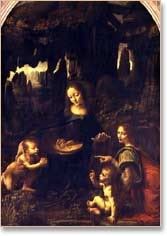Saturday, January 29, 2005

"Virgin of the Rocks was the first painting executed by Leonardo after he arrived in Milan. Critics argue over exactly what the painting depicts; some claim it shows the immaculate conception, while others think it recalls the moment when the infant Christ met St John the Baptist.When Leonardo was commissioned to paint this piece, he was given a year to complete it. True to form, he over-ran, and a lengthy law suit followed. Leonardo also fell out with his sponsors over how much he should be paid for the work. Perhaps this is why he began a second version of the painting to give to the commissioners, selling the first on elsewhere.See the National Gallery version of this painting. There is some debate as to whether both artworks are entirely by Leonardo. In particular, the version that hangs in the National Gallery may have been a collaboration between Leonardo and a second artist, or may have been a project which he simply oversaw.
The painting is set in a cave. Was he giving himself an opportunity to paint nature - or was he implying that nature was his church?Leonardo has painted light to give this picture structure and form. Before Leonardo, artists had only used light crudely in their work."
in
BBC
1 Comments:
"We can always tell a Leonardo work by his treatment of hair, angelic in its fineness, and by the lack of any rigidity of contour. One form glides imperceptibly into another (the Italian term is sfumato), a wonder of glazes creating the most subtle of transitions between tones and shapes. The angel's face in the painting known as the Virgin of the Rocks in the National Gallery, London, or the Virgin's face in the Paris version of the same picture, have an interior wisdom, an artistic wisdom that has no pictorial rival.
This unrivalled quality meant that few artists actually show Leonardo's influence: it is as if he seemed to be in a world apart from them. Indeed he did move apart, accepting the French King François I's summons to live in France. Those who did imitate him, like Bernardini Luini of Milan (c.1485-1532) caught only the outer manner, the half-smile, the mistiness.
The shadow of a great genius is a peculiar thing. Under Rembrandt's shadow, painters flourished to the extent that we can no longer distinguish their work from his own. But Leonardo's was a chilling shadow, too deep, too dark, too overpowering."
in http://www.ibiblio.org

